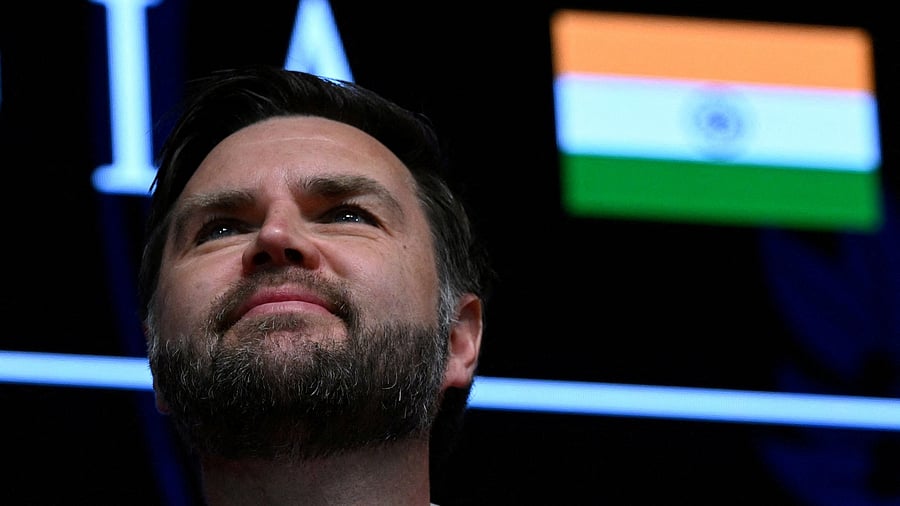
U.S. Vice President JD Vance reacts as he delivers remarks at the Rajasthan International Centre in Jaipur, on Tuesday, April 22, 2025.
Kenny Holston/Pool via REUTERS
New Delhi: Even as President Donald Trump’s administration announced finalisation of the Terms of Reference of the India-US trade deal, his Vice President J D Vance on Tuesday nudged New Delhi to lower non-tariff barriers and warned of "dire consequences" if the two nations lag in the manufacturing, energy and infrastructure sectors.
Vance prodded India to buy more military hardware from the US, including the fifth-generation F-35 fighter aircraft, which, according to him, would give the Indian Air Force the ability to protect the citizens of the country like never before.
"From Javelins (Anti-Tank Guided Missiles) to Stryker combat vehicles, our nations will co-produce many of the munitions and equipment that we will need to deter foreign aggressors, not because we seek war, but because we seek peace and we believe the best path to peace is through mutual strength,” said the US vice-president. “We believe a stronger India means greater economic prosperity but also greater stability across the Indo-Pacific,” he added, sending out a message to China.
“Neither Americans nor Indians are alone in looking to scale up their manufacturing capacity. The competition extends well beyond cheap consumer goods and into munitions, energy, infrastructure, and all sorts of other cutting-edge technologies,” Vance said in Jaipur a day after meeting Prime Minister Narendra Modi in New Delhi. “I believe that if our nations fail to keep pace, not just for the Indo-Pacific, but the consequences for the entire world will be quite dire.”
His comment was apparently intended to underline the implications for the countries in the Indo-Pacific region and beyond if China continued to have an edge over India, the US and others in manufacturing and high-tech sectors.
“If India and the US work together successfully, we're going to see a 21st century that is prosperous and peaceful,” Vance said while delivering a speech at the Rajasthan International Centre in Jaipur. “But I also believe that if we fail to work together successfully, the 21st century could be a very dark time for all of humanity.”
Vance announced that India and the US has finalised the Terms of Reference of the bilateral trade agreement, which Modi and Trump had on February 13 agreed to clinch by the fall of this year. US Trade Representative, Jamieson Greer, also confirmed in Washington, DC, that the Trump administration had finalised with New Delhi the Terms of Reference “to lay down a roadmap for the negotiations on reciprocal trade” with India.
“There is a serious lack of reciprocity in the trade relationship with India. These ongoing talks will help achieve balance and reciprocity by opening new markets for American goods and addressing unfair practices that harm American workers,” Greer said in Washington, DC, welcoming India’s constructive engagement with the US on the issue.
Vance called Modi “a tough negotiator who drives a hard bargain”. “We don't blame Prime Minister Modi for fighting for India's industry, but we do blame American leaders of the past for failing to do the same for our workers,” he said, adding: "We believe that we can fix that to the mutual benefit of both the US and India.”
He said that Trump wanted to rebalance global trade so that America, with "friends like India", can build “a future worth having for all of our people together”.
The US goods imports from India totalled $87.4 billion in 2024, 4.4 per cent or $3.7 billion more than in 2023. India imported goods worth $41.75 billion from the US in 2024. India was the destination of 2.02 per cent of exports in 2024. The US goods trade deficit with India was $45.6 billion in 2024, an increase of $2.3 billion (5.3 per cent) over 2023.
The USTR noted that India’s average applied tariff of 17 per cent was among the highest of the world’s largest economies, while the average tariff applied by the US was just 3.3 per cent. India’s average applied tariff rate on agricultural products was 39 per cent, while the US average applied tariff on agricultural products was just 5 per cent, according to a factsheet released by the office of Greer. “In addition to tariffs, technical barriers to trade, regulatory barriers, and restrictions on access to the market in the services, industrial, and agricultural sectors also reduce US exports to India.”
Trump, on April 2, imposed additional ad-valorem duties ranging from 10 per cent to 50 per cent on imports from all trading partners of the US. The executive order imposed an additional duty of 27 per cent on India’s exports to the US. He later paused the implementation of his “reciprocal tariff” for all nations, except China, for 90 days.
Vance on Tuesday lauded the Modi government for promising to amend the Civil Liability for Nuclear Damage Act, which hindered the participation of the US companies in the generation of atomic power in India. “We believe that American energy can help realise India's nuclear power production goals,” said the US vice president.
